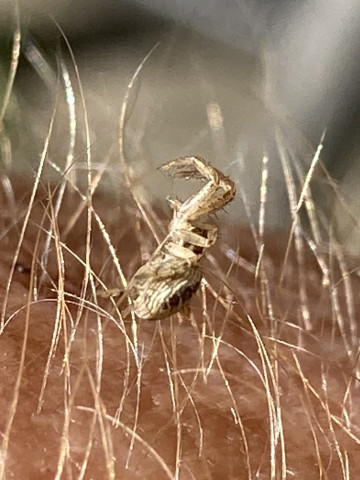![]() This page is regularly updated, please select here to view the latest version.
This page is regularly updated, please select here to view the latest version.
August 2023
Arrival of the arachnids_______The Common Crab spider
 It’s that time of year again, when spiders seem to become a lot more visible and numerous, especially one of the largest of UK species, the house spider. But, although the least favourite time for arachnophobes, spiders are of course present throughout a good deal of the year. Autumn happens to be the time when they reach full size, and males are on the move seeking out the more sedentary females, for mating.
It’s that time of year again, when spiders seem to become a lot more visible and numerous, especially one of the largest of UK species, the house spider. But, although the least favourite time for arachnophobes, spiders are of course present throughout a good deal of the year. Autumn happens to be the time when they reach full size, and males are on the move seeking out the more sedentary females, for mating.
My recent encounters with creatures in the Class Arachnida, was outdoors whilst gardening . It involved one small spider and one very long legged harvestman. I discovered in researching the subject, that there are a number of Orders within Arachnida, including those containing ticks, scorpions and harvestmen, as well as the all too familiar spiders. So, despite superficial likenesses, spiders and harvestmen are not closely related.
Arachnids are different from insects in having 8 legs, rather than 6, and 2 body parts instead of 3. And the Order comprising spiders, have fangs that inject venom, spinnerets that produce silk and mostly, 4 pairs of eyes; they lack antennae. There are over 45,000 species of spider worldwide, occurring on every continent except Antarctica. The UK is thought to have in excess of 650 species. A study of an undisturbed grass field in Sussex found 5.5 million spiders per hectare; a colossal colony and a veritable jungle in miniature. Spiders are carnivorous and will feed on one another as well as other insects. It’s a battle for survival. 
The first arachnid to cross my path, or rather, crawl up my arm, was a tiny crab spider, with the impressive name of Xysticus cristatus; the most common crab spider in the UK. As you can see from the photo, this male is only about 5mm in length, slightly less than the hairs on my arm!! These are called crab spiders for their similarity in appearance to crabs and also their ability to move sideways and backwards.
Of their eight legs, the front two pairs are stronger and longer than those at the back and are held out to the side of the body in a crab like fashion. These spiders don’t create webs to ensnare their prey, but are ambush predators. They sit with their legs splayed waiting for some unsuspecting insect or other bug, to wander past. They then grab their prey, securing them with the spines on their front legs (see photo) before biting them and injecting a paralysing venom. The venom also contains enzymes that break down the bodies of prey to make them easier for the spider to ingest. They may be small but they’re fearsome and can actually tackle prey much larger than themselves. But fortunately their bite isn’t strong enough to pierce the skin of humans, so they’re quite harmless as fas as we’re concerned. Phew!
 Although these particular spiders don’t produce webs, they do spin silk, which plays a part in their somewhat unusual mating ritual. The male spider grabs the female by one of her legs and then secures her to the ground with threads of silk before crawling underneath and mating with her. The spider in the photo is a male because he has the small protuberances at the front resembling mini boxing gloves. These are called pedipalps and are where the semen is stored. Having concluded their less than subtle mating, the female walks away, presumably unharmed and unfazed, to lay her eggs. He also generally survives the encounter and is lucky because in other species the female often eats the male after mating.......and possibly with far less cause!
Although these particular spiders don’t produce webs, they do spin silk, which plays a part in their somewhat unusual mating ritual. The male spider grabs the female by one of her legs and then secures her to the ground with threads of silk before crawling underneath and mating with her. The spider in the photo is a male because he has the small protuberances at the front resembling mini boxing gloves. These are called pedipalps and are where the semen is stored. Having concluded their less than subtle mating, the female walks away, presumably unharmed and unfazed, to lay her eggs. He also generally survives the encounter and is lucky because in other species the female often eats the male after mating.......and possibly with far less cause!
The female crab spider deposits the eggs in a sac that she’s woven from her silk and secured in a safe place. She then guards the eggs at least until they hatch, during which time she doesn’t feed. As a consequence, she dies of starvation, having hopefully ensured the survival of the next generation.
So, as you can see, if it’s a wildlife spectacle you’re seeking, you need travel no further than your garden or your local park. Take a moment, get down and close, and it’s surprising what you come across.
Next time it’s the equally intriguing tale of the Harvestman. Watch this space!
Words and photographs by Denise Long
![]()


